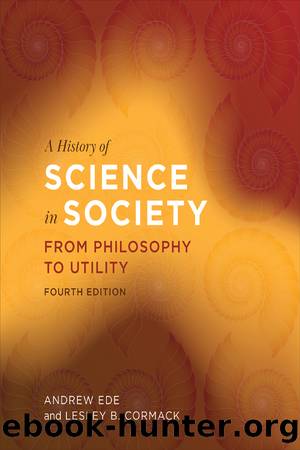A History of Science in Society by Ede Andrew;Cormack Lesley B.;

Author:Ede, Andrew;Cormack, Lesley B.;
Language: eng
Format: epub
Tags: Science – History, Science – Social aspects – History, Science – Philosophy – History
Publisher: University of Toronto Press
The Professionalization of Science and Science Education
It is not surprising that the era that shaped Darwinian theory was also the era that produced Sherlock Holmes, Sir Arthur Conan Doyleâs cool, scientific, and supremely logical private detective. Scientists, even if they continued to argue the fine details, seemed to be revealing all of nature, and it seemed possible to create a complete picture of how the physical world operated. With such knowledge, no secret could be kept from the observant mind. Darwin and Sherlock Holmes were also alike in being amateurs rather than professionally trained and employed. While Holmes gave metaphorical birth to generations of private detectives, Darwin, as gifted and insightful as he was, represented the waning of a scientific style. He was the last of the great amateur gentleman scientists. For science as an occupation, the nineteenth century was a turning point. There was an increasing sense of science as a professional activity, and with this came a growing separation of the study of nature as a branch of philosophy. This was spurred by the appearance of more and increasingly specialized scientific organizations and the development of new institutions in education and research dedicated to science. While it may have been used by German academics earlier, the term âscientistâ was a product of the nineteenth century, introduced by William Whewell (1794â1866) to a large audience at a meeting of the BAAS in 1833.
The reign of Napoleon offers a good starting point for the expansion of science as a profession. Although Napoleonâs actual support for science was somewhat variable (for example, he abandoned a number of scientists in Egypt when he escaped the British there), he did foster a sense of the importance of technical knowledge. The Académie des Sciences was disbanded in 1793 during the Revolution, but it re-emerged in 1795 as part of the Institut National. In addition to the Académie Napoleon approved the foundation of the Société dâArcueil in 1805, which had as members such leading thinkers as Claude Berthollet, Pierre-Simon Laplace, and Alexander von Humboldt.
More important than the Société dâArcueil was the transformation of the Ãcole Polytechnique into the leading scientific and engineering school of the era. Originally founded as the Ãcole centrale des travaux publics in 1794 by the National Convention, it changed its name in 1795 and absorbed the state artillery school in 1802. First under the Ministry of the Interior, the connection with the military was completed in 1804 when Napoleon transformed it into an elite military school. The artillery had always been the most intellectual branch of the military, requiring a broad understanding of mathematics, physics, chemistry, and elements of what we would call materials science. At the same time, the artillery was not steeped in ancient traditions and offered a path to military command that was not determined solely by social rank. It had attracted many bright young men of lower birth, including Napoleon, who was commissioned as an artillery officer in 1785.
The Ãcole Polytechnique was founded by three men: Lazare
Download
This site does not store any files on its server. We only index and link to content provided by other sites. Please contact the content providers to delete copyright contents if any and email us, we'll remove relevant links or contents immediately.
De Catalaanse brief by Robert Goddard(317)
A Piece of Cake by Sarah Swatridge(251)
Churchill's Spearhead by John Greenacre(227)
Nonlinear Dynamics and Chaos with Student Solutions Manual by Steven H. Strogatz(219)
The Ruin of J. Robert Oppenheimer by Priscilla J. McMillan(192)
Flowering of the Cumberland by Harriette Simpson Arnow(174)
Popular Culture and Political Identity in the Arab Gulf States by Alanoud Alsharekh Robert Springborg(173)
thing bounces back europe by Unknown(165)
Allied Bombing Raids by Philip Kaplan(162)
A Japanese View of Nature by Kinji Imanishi Pamela J. Asquith(157)
Guild and State by Antony Black(153)
Comet Madness by Richard J. Goodrich(152)
RAF at the Crossroads by Greg Baughen(139)
History Without A Subject by David Ashley(135)
A History of Greek and Roman Philosophy by John Hackney(134)
The Seventies Now: Culture As Surveillance by Stephen Paul Miller(134)
A History of Science in Society by Ede Andrew;Cormack Lesley B.;(130)
Air Battle for Burma by Evans Bryn;(128)
Shocking Bodies by Iwan Rhys Morus(126)
